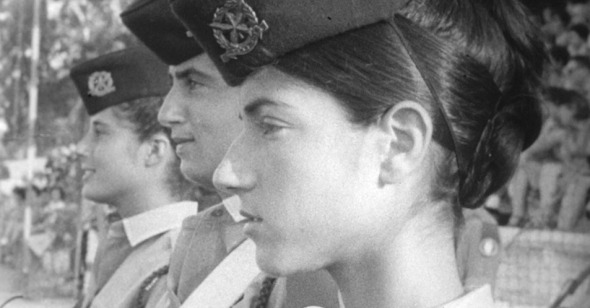Power Source
By Chrissy Griesmer
Israel Palestine on Swedish TV 1958–1989
Dir. Göran Hugo Olsson, Sweden, Icarus Films
In a 1991 piece for the French publication Libération, the late critic Serge Daney wrote on the subject of television during the Gulf War:
“Television is watched because it is indeed very realist…. One cannot rebel against TV any more than one can stop breathing because of ecological convictions. Except for one thing: the only world of which television never ceases giving us news…is the world seen from the viewpoint of power (just as we say 'the earth seen from the moon’). That is its only reality. Without TV, how would we know who has power and who doesn’t? Who’s worth something and who’s worth nothing?”
Daney’s writing, specific to its time, is useful in considering the new documentary Israel Palestine on Swedish TV 1958–1989 (IPSTV). Directed by Göran Hugo Olsson, it’s an assemblage of footage broadcast on and preserved by Sveriges Television (or SVT), Sweden’s TV network, on Israel and Palestine. Olsson selects and chronicles the footage while trying to preserve an agnostic Swedish perspective, which was the network’s mandate, along with a presumably educational imperative. It’s unclear what Olsson makes of SVT’s provincial framing—he remains mum on the subject. But the desired effect is that the conscientious viewer, alert to the discrepancies between the material and the political history known at present, can arrive at some truth.
SVT is a state-sponsored broadcast network, which began in 1957 and held a monopoly in Sweden until the end of the Cold War in 1989. Olsson is no stranger to SVT’s collection; he has borrowed from it in archival films such as The Black Power Mixtape 1967–1975 (2011) and Concerning Violence (2014), though these weren’t bracketed by the broadcaster’s dominant era, a careful choice made by Olsson. Nearly all of SVT’s content was made by Swedes, and the volume of footage in this nearly three-and-a-half-hour film tells us the archive is in good health. Clips of its viewing room make their way into the film, but I also glimpsed the vaults in a presentation delivered by Olsson during the “Working on It” program at the 2025 First Look festival, which included a photo of some neatly stacked 16mm canisters.
The film offers a hands-off engagement with the “conflict,” as it is called. Olsson montages significant turning points (the Six-Day War, the Yom Kippur War, the Sabra and Shatila massacre); underscores sequences with pulsing mood music or, at one point, “Angel” by Massive Attack; and incorporates voiceover from an offscreen woman who flatly reads off archival cards. But beyond these touches, the method is unobtrusive. (Perhaps the filmmaker wishes not to editorialize, though an artistic project of this sort can hardly avoid it.)
Broadly, IPSTV is positioned between two opposing poles, Israel and Palestine, in a manner that, similar to its title, parodies archival classification; the conflict becomes an equivocation. Olsson does not present his film as a history of Palestinian decolonial struggle, but one, largely from a particular, erroneous, Swedish perspective, in which Israel is representative of all Jews in a state that arose out of the Holocaust.
Olsson’s technique of recycling broadcast films to provide a quasi-popular history demonstrates shifts in broadcast journalism over time. Once incorporating interviews with Ghassan Kanafani and Leila Khaled, SVT trends towards paternal humanitarian coverage of Palestine during the First and Second Intifada. Unseen throughout, however, is how television was shaped by sociohistorical eras. After the ’50s, the medium had considerable influence, and militant groups took note of its live, durational quality whereby they staged political events around media spectacles. The Dawson’s Field incident in 1970—during which the Popular Front for the Liberation of Palestine hijacked four aircrafts, three of which defected to an airstrip in northern Jordan, for the release of Palestinian political prisoners—led to a press conference with the captives organized by the hijackers. (Interviews with TV anchors during the hostage crisis, which has a natural countdown clock, offered publicity.) In the film, the event becomes one that has merely happened rather than one that was produced; excepting a clip in which one hostage describes the hijackers as “very pleasant . . . loved the children,” Olsson devotes minimal time to the incident and downplays the guerilla theatrics that once took advantage of media power.
Would preserving the Swedish account mean leaving the material unaltered? Probably, though watching 32 years of wholesale footage might not sit well for viewers with short attention spans. Seesawing between coverage of Israel and Palestine while remaining quietly aware of Israel’s monopoly on legitimized violence (such that the state continues its greenlit genocide against the Palestinians with impunity), the documentary somewhat obscures SVT’s faulty framing. There’s a disclaimer about the limited purview archival materials provide, but the attenuated coverage, which mimes the totalizing experience of watching television, even if fitfully, leaves little room for thinking or a chance to puncture the stream of clips. (The segments sit cheek by jowl given Olsson has teased a televised version of IPSTV.) A long quotation of the archive, and absent anything that exists outside of it or probes the journalism, the film shies from political directness. The resultant risk is a both-sides-ism and reinforcement of inoffensive, emotional reactions that treat the “conflict” as simply harrowing or history repeating itself.
Can we expect, according to Daney, “the world seen from the viewpoint of power” to have such a fair perspective, even if viewed from a small but wealthy country like Sweden? Probably not. But the film’s impartiality and supposed distance enabled by time implies the further one gets from the material, the greater truth-claim one can make. When distance is not all that distant—the spate of footage echoes broadcasts seen today—and that which sits beyond the archive is excluded, in the end what the film recollects is the repetition of images.
